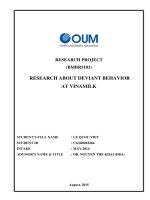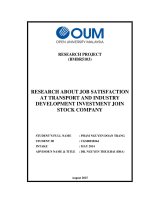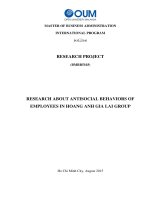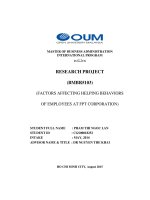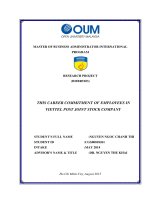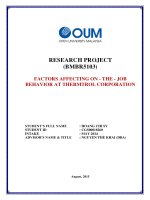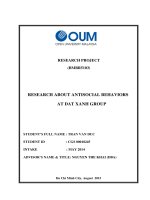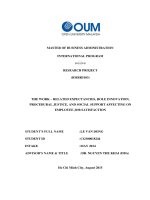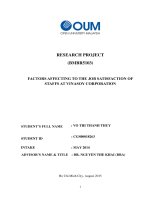Research about career commitment at sagontourist corporation
Bạn đang xem bản rút gọn của tài liệu. Xem và tải ngay bản đầy đủ của tài liệu tại đây (1.21 MB, 59 trang )
MASTER OF BUSINESS ADMINISTRATION
INTERNATIONAL PROGRAM
RESEARCH PROJECT
(BMBR5103)
RESEARCH ABOUT
CAREER COMMITMENT AT
SAIGONTOURIST CORPORATION
STUDENT’S FULL NAME
: NGUYEN THI THU TAM
STUDENT ID
: CGS00019365
INTAKE
: MARCH 2015
ADVISOR’S NAME & TITLE
: NGUYEN THE KHAI (DBA)
Ho Chi Minh City, July 2016
A
DVISOR’S ASSESSMENT
……………………………………………………………………………………………………………………………………………………..
……………………………………………………………………………………………………………………………………………………..
……………………………………………………………………………………………………………………………………………………..
……………………………………………………………………………………………………………………………………………………..
……………………………………………………………………………………………………………………………………………………..
……………………………………………………………………………………………………………………………………………………..
……………………………………………………………………………………………………………………………………………………..
……………………………………………………………………………………………………………………………………………………..
……………………………………………………………………………………………………………………………………………………..
……………………………………………………………………………………………………………………………………………………..
……………………………………………………………………………………………………………………………………………………..
……………………………………………………………………………………………………………………………………………………..
ADVISOR’S SIGNATURE
(July 2016)
NGUYEN THE KHAI (DBA)
A
CKNOWLEDGEMENTS
Dear Dr Khai,
In my memory, you are very and very good lecturer.
I have been received your many things and my classmates during research progress.
The efforts of many people are needed to develop and improve this research such as
members of family, friends, colleagues, SaigonTourist.
Among these people are the reviewers and consultants; their viewpoints out areas of
concern, cite areas of strength, and make recommendations for change.
Thanks and the best for all.
Nguyen Thi Thu Tam Student
C
ONTENTS
ABSTRACT
1
INTRODUCTION
2
About SaigonTourist
2
History
2
Development and investment
3
Scope
5
Corporate culture
6
Contact
7
Research problem statement
9
Research objectives
9
Research scope
10
Significance of research
10
LITERATURE REVIEW
11
Definition of constructs
11
Career Commitment
11
Developmental Experiences
12
Career Satisfaction
12
Perceived Ability Job Fit
13
Perceived Importance of Work Place Values
14
Argument for the relationship among the constructs
14
Ajzen and Fishbeins’ Theory of Reasoned Action
14
Herzeberg’s two factors theory
16
Vroom’s expectancy theory
18
Maslow’s theory
19
Hackman and Oldham’s job characteristics
20
Adams' equity theory
21
Goal setting theory
23
Hypotheses
24
Research model
24
METHODOLOGY
25
Data collection
25
Career Commitment
25
Developmental Experiences
26
Career Satisfaction
27
Perceived Ability Job Fit
28
Perceived Importance of Workplace Values
28
Progress and timeline of data collection
29
Data analysis
30
RESULTS
31
Cronbach’s Alpha
31
Statistics information
31
Descriptive statistics
31
Correlation statistics
32
Hypotheses testing
33
Hypothesis suggested (H1)
33
Hypothesis suggested (H2)
34
Hypothesis suggested (H3)
35
Hypothesis suggested (H4)
36
CONCLUSIONS
37
Discussion
37
My viewpoint
37
My forecast
38
Limitation of research
38
REFERENCES
39
APPENDIX
44
Appendix 1: Survey
44
Appendix 2: Presentation
48
L
IST OF FIGURES AND TABLES
Figure 1
: Ajzen and Fishbein's Theory of Reasoned Action
15
Figure 2
: Vroom’s Expectancy Theory of Motivation
19
Figure 3
: Research model
24
Table 1
: Career Commitment
26
Table 2
: Developmental Experiences
27
Table 3
: Career Satisfactory
23
Table 4
: Perceived Ability Job Fit
28
Table 5
: Perceived Importance of Workplace Values
29
Table 6
: Cronbach’s Alpha
31
Table 7
: Descriptive statistics
32
Table 8
: Correlation statistics
33
Table 9
: Model summary of H1
34
Table 10
: Coefficients of H1
34
Table 11
: Model summary of H2
34
Table 12
: Coefficients of H2
35
Table 13
: Model summary of H3
35
Table 14
: Coefficients of H3
35
Table 15
: Model summary of H4
36
Table 16
: Coefficients of H4
36
Business Research Methods
A
Nguyen Thi Thu Tam - ID: 19365
BSTRACT
This study examined the impact of career commitment. Data was
collected with standardized questionnaires. The collected data
computed and analyzed through factor analysis, Cronbach’s Alpha,
descriptive statistics, correlation, and multiple regression analysis.
In my research, I designed research model include:
Developmental Experiences, Career Satisfaction, Perceived Ability Job Fit and
Perceived Importance of Workplace Values are Independent Variables (IV)
Career Commitment is Dependent Variable (DV)
Four IV factors will influence to DV factor.
The findings in this study would help managers of SaigonTourist to formulate
strategies that involved work factors such as distributive and procedural to improve the
management of human resource development. These strategies would help in
influencing positive behaviors among employees, and hence achieve effectiveness and
high productivity in the organization. Therefore, it was worth the effort for the
organization to train and educate their managers on the impact of perceptions of
organizational justice on the motivation and commitment of their employees.
Key words in this research: Career Commitment, Developmental Experiences, Career
Satisfaction, Perceived Ability Job Fit, Perceived Importance of Workplace Values
and SaigonTourist.
Page 1 / 52
Business Research Methods
Nguyen Thi Thu Tam - ID: 19365
I
NTRODUCTION
About SaigonTourist
History
Companies Travel Ho Chi Minh City was formed and in operation since
1975. In 31/03/1999, as decided by the People's Committee of Ho Chi Minh City,
Saigon Tourist (SaigonTourist) was established, comprised of member units, which
took tourist company in Ho Chi Minh city as the core.
SaigonTourist is Vietnam National Administration of Tourism rated as one of the
leading enterprises in the tourism sector due to the positive contribution in the
development of the tourism industry in the country with many service models.
With the motto "Brand - Quality - Efficiency - Integration", SaigonTourist will focus
on increasing business efficiency, improve service quality, development of investment
capital to upgrade facilities, development of new products featuring the traditional
culture, strengthen the propaganda - promotion - marketing to the target market and
potential.
As an official member of the World Tourism Organization as PATA, JATA, USTOA,
and cooperative relationship with more than 200 companies of international travel
services of 30 countries, SaigonTourist will continue to focus on developing markets,
especially international target markets such as Japan, China, Taiwan, Singapore,
Korea, France, Germany, Britain, Canada, the United states...Through the promotion
of new products on accommodation, restaurants, travel. shopping, MICE, tourism and
Page 2 / 52
Business Research Methods
Nguyen Thi Thu Tam - ID: 19365
river ships. To ensure sustainable growth, SaigonTourist will actively developing
branches in Southeast Asia. With strong capability and vision on the future of the
tourism industry of Vietnam, SaigonTourist continue to strive to expand the market
and towards Vietnam on par with the Asian Tour.
Development and investment
In Vietnam, SaigonTourist is now the largest tourism trademark. Over the years,
SaigonTourist has diversified business areas, and currently manages 8 travel service
companies, 54 hotels, 13 resorts and 28 restaurants with full amenities. In the field of
joint venture, SaigonTourist has invested in more than 50 joint-stock companies and
limited liability companies in the country and 9 foreign-invested joint ventures,
operating in major cities across the country.
To make the SaigonTourist trademark more impressive for visitors, SaigonTourist is
calling both domestic and foreign investors for hotel and tourist site projects in
provinces and cities. This activity not diversifies and improves the product and service
quality of the SaigonTourist system, but also contributes to the development of the
Vietnamese tourism industry. SaigonTourist is proud to be a pioneer in developing
Vietnamese tourism, particularly tourism sites in Hue, Ha Long, Nha Trang, Phu Quoc
and Mui Ne.
In the central area of Ho Chi Minh City:
The Corporation owns a hotel chain standards like 5 star and 4-star Sheraton Hotel,
Caravelle Hotel, Newold Hotel, Rex Hotel, Majestic Hotel, Continental Saigon Hotel,
Grand Hotel, Kim Do Hotel, Oscar Saigon Hotel, First Hotel, Palace Hotel, Liberty
Page 3 / 52
Business Research Methods
Nguyen Thi Thu Tam - ID: 19365
Saigon Riverside Hotel, Saigon Liberty Centre Hotel, Novotel Hotel, Saigon Bong Sen
Hotel, Homeland - Liberty 2 Hotel, Hometown - Liberty 3 Hotel, Que Huong - Liberty
4 Hotel, Dong Khanh Hotel, Thien Hong Hotel; Bat Dat Hotel, Cholon Hotel, Thanh
Binh Cluster Hotel, Can Gio Resort, Binh Quoi tourist Village,…
Regarding investment in other localities, SaigonTourist has poured capital into various
projects like:
In the Central Viet Nam:
The Corporation owns a chain of hotels of 4 stars standard resort as Saigon - Mui Ne
Hotel, Saigon - Ninh Chu Hotel, Saigon – Dalat Hotel, Yasaka - Saigon - Nha Trang
Hotel, Sai Gon - Ban Me Hotel, Saigon - Phu Yen Hotel, Saigon - Quy Nhon Hotel,
Saigon - Morin Hotel; Saigon - Quang Binh Hotel; Sai Gon - Dong Ha Hotel, Saigon Kim Lien Hotel; Saigon Tourane Hotel. Besides, SaigonTourist will invest in Bai Dai
resort (Cam Ranh City) and the 209-hectare Phu Quoc resort (Phu Quoc Island).
In the Northern Viet Nam:
The Corporation owns a chain of hotels of 4 stars standard as Saigon Ha Long Hotel,
Majestic Mong Cai Hotel, Saigon Ba Be Hotel,...
Concentrating on financial investment is one of SaigonTourist’s important strategies.
Currently, apart from investment in the tourism industry, SaigonTourist also
contributes capital to finance and aviation, for example buying stakes of Saigon
Industrial and Commercial Joint Stock Bank, Vietnam Import - Export Bank
(Eximbank), Oriental Bank, Kien Long Commercial Joint Stock Bank, Vietnam
Investment Fund, Pacific Airlines, South Saigon Development Company and others.
Page 4 / 52
Business Research Methods
Nguyen Thi Thu Tam - ID: 19365
SaigonTourist also has acquired stakes in international investment funds. These are
preparatory steps for listing SaigonTourist shares on the stock market in the coming
time. The investment strategy will also help SaigonTourist fulfil its targets of VND
18.000 billion revenue in 2015 and VND 32.000 billion revenue in 2020.
Scope
Hotel, Resort
Restaurants
Travel
Entertainment
Trade, export and import
Duty free shops
Transport
Construction
Professional training in tourism & hospitality
Manufacturing & processing, food...
Vision and Misson and Field work
Vision:
SaigonTourist to become one of the leading travel brand in Southeast Asia,
empowering image of Vietnam. Development trends of integration, sustainable,
efficient business value associated with the local culture, community benefits.
Mission:
SaigonTourist done to maximize business efficiency. Gives customers the experience
Page 5 / 52
Business Research Methods
Nguyen Thi Thu Tam - ID: 19365
through the product line, unique service chain, differences, contains cultural and
spiritual values with international quality. Promote the image, the quintessence of
traditional Vietnamese and identity. To fully exploit the synergy from the main areas
of activity, contributing to the development of Vietnam's tourism to new heights.
Core values:
Saigontourist is brand reputation of tourism, hotels in Vietnam and the region.
Longstanding cultural foundations imbued with national identity. System products,
diversified services, standards, high level. Traditional hospitality and professionalism,
responsibility, dedication, meet the diverse needs, advanced needs of customers.
Field work:
Saigontourist influential and broad scope of activities in the tourism sector, is an
organizational member of the prestigious travel domestically and internationally.
Saigontourist business activities in four main areas: hotels - tourism, restaurants, tours,
and entertainment. At the same time, Saigon Tourist use of the advantages of the
services related to the investment services and supports control, using the advantage of
the expertise to perform multiple functions, thereby improving operational efficiency
and maximizing business competitiveness.
Corporate culture
SaigonTourist has always put quality issues to the forefront, therefore each member of
the Corporation are always immersed in the culture of SaigonTourist carrying its own
identity. Every company, every business wants to create a solid position in the market
need to create a culture to bring their own identity. SaigonTourist also, the program
Page 6 / 52
Business Research Methods
Nguyen Thi Thu Tam - ID: 19365
awarded honors and Vietnam Tourism Awards 2015, the Company Limited
SaigonTourist Travel Service (under the Saigon Tourist Company) honored and proud
to be the Deputy Prime Minister Vu Duc Dam and the Minister of Culture, Sports &
tourism, Nguyen Ngoc Thien, Chairman of Vietnam tourism Association Nguyen Huu
Tho awarded prizes, Awards travel in Vietnam in 2015, with achievements in # 1 of 4
title of "Top International Travel Vietnam", "Top Travel Vietnam Homeland",
"Foreign Travel in Vietnam," the title of "Enterprise business transporting tourists by
leading automobile". This is the highest title of the tourism industry of Vietnam,
SaigonTourist maintain continuous years.
Saigontourist has traditionally good always interested in the health of the community,
the staff of the Saigon Tourist has expressed solidarity and sent his heart into every
product and service. This culture has contributed to the domestic brands as well as
strong international Saigontourist. Saigontourist culture not only take care of the
employees, but also for the overall development activities of the community and
society. . Saigon Tourist implementation of the program "for the purposes of
community Saigontourist" for many years. In 2015, Saigon Tourist has contributed to
the community as follows:Lunar New Year, has conducted a comprehensive and
practical implementation, contribute to raising awareness, confidence-LD CNVC
ensure the spirit of "not to an employee does not have the New Year." Coordinate with
concerned leaders than 10,000 CNVC-LD Festival with a total amount of 60
billion.The scholarship program "Nguyen Duc Canh" and "SaigonTourist" movement
"piggy culture" earned VND 1 billion VND 250 million, 135 grant awarded interest
Page 7 / 52
Business Research Methods
Nguyen Thi Thu Tam - ID: 19365
corporations, over 900 grassroots, aided CNVC-LD's children have had much
difficulty trying to rise to good learning.
"Spring Connection Program love" for the members of the Group of 85 - Workers with
special circumstances difficult or more consecutive years are not home to the province,
a total budget of about VND 200 million. Collaborate with unit leaders to take care of
90 cases with difficult circumstances, the total value of VND 200 million.
Collaborate with Vietinbank Bank branch 7, Ho Chi Minh City and the member units
SaigonTourist organized "Mid-Autumn Festival 10th 2015" for 1,560 children in
difficult circumstances, overcoming difficulties to study well in Lam Dong province,
Gio and some units of the Corporation. The total value of nearly VND 600 million.
In addition, SaigonTourist has supported the charitable activities of the city and the
country of nearly VND 500 million. Total of the year 2015 : VND 5.5 billion.
Contact
Headquarters: No. 23 Le Loi Street, District 1, Ho Chi Minh City
Tel: +84.8 3829 2291 / Fax: +84.8 3829 5887 / Web: www.saigon-tourist.com
Page 8 / 52
Business Research Methods
Nguyen Thi Thu Tam - ID: 19365
Research problem statement
Tourism human resources is one of the most important factors is crucial in the process
of tourism development, because a human being is the subject of labor activity.
Tourism to develop to become a key economic sector requires human resources with
high quality, especially during the current integration.
SaigonTourist is not outside that orbit. With the shortage of human resources at
present, retaining and training skilled human resources are becoming major issues of
Saigontourist. General Manager realized the commitment expressed in the career is the
bond between the organization and the employee.
The leading companies have recognized that the key to attracting and maintaining a
flexible workforce and sophisticated level of technology for the company to achieve
success in the digital economy today is to give staff a synthetic variety of opportunities
for professional development and skills.
Research objectives
The purpose of this study was to find out how these factors affect the commitment to
career for employees working in SaigonTourist, include:
Gather relevant information to try to determine what that involves commitment
to employee career at SaigonTourist.
Design research model and the factors related test, analysis, assessment of
factors affecting the level of weakness, strength of each factor affecting factors
to analyze.
Page 9 / 52
Business Research Methods
Nguyen Thi Thu Tam - ID: 19365
Locate solutions to improve efficiency and prediction of HRM at the
SaigonTourist in the coming period.
Research scope
This research focuses to issues related to Career Commitment of the employees of
SaigonTourist based on their current operating mode and working condition.
Scope of the survey are in the territory of Ho Chi Minh City, including 500 employees
of the system of SaigonTourist.
Contents of this study only includes factors affecting the career commitment at the
SaigonTourist, it has no intention of restructuring, changes and replacement of staff.
These surveys were conducted from May 1 to July 15, 2016.
Significance of research
The result of this study is a valuable contribution to help executives; managers
understand and be more aware of the importance of career commitment, career success
by presenting the findings the intermediate effects of career satisfaction about the
relationship between commitment and successful business career in the context of
subjective service industry. In addition, team leaders, managers, dynamic, creative
agency, it also improves employee loyalty to organizations, and more employees will
be loyal to the shareholders of the company companies, contributed to the success of
SaigonTourist.
Page 10 / 52
Business Research Methods
Nguyen Thi Thu Tam - ID: 19365
L
ITERATURE REVIEW
Definition of constructs
Career Commitment
This measure, developed by Blau (1989), has been widely used to
examine individuals’ commitment toward their occupations, profession, and careers.
Reil ly and Orsak (1991) modified the items to fit the nursing profession. The measure
could be similarly adapted to fit other specific professions.
Three items developed by Gartner and Nollen (1989) were used to measure the
employee’s perception about internal promotion within the company.
Perceived Company-Provided Training:Three items developed by Gartner and Nollen
(1989) were used to measure how the respondents perceive the effectiveness of the
training provided by the company.
Perceived Employment Security: One item developed by Gartner and Nollen (1989)
was used. The item asks whether the respondent believes that the company has done
all it can to avoid layoffs.
Factor analysis showed that career commitment was empirically distinct from affective
organizational commitment, continuance commitment, and normative commitment
(Cohen, 1996). Career commitment was been also shown to be empirically distinct
from job involvement and a measure of the Protestant work ethic (Cohen, 1999)
Page 11 / 52
Business Research Methods
Nguyen Thi Thu Tam - ID: 19365
Developmental Experiences
This measure, developed by Wayne, Shore, and Liden (1997), describes the formal and
informal developmental experiences a job affords employees. The measure focuses on
the extent to which an organization makes discretionary investments in formal and
informal training and development of an employee.
Experience professional development is a term that describes the experience of
training, work practices, mentoring relationships help employees progress in their
careers. Any company that aims to retain the most valuable employees and
replacement positions are vacant due to retirement, left the company, promoted from
within the company... must implement development programs job.
Career Development Recipes:
Create professional ladder for all the people you wish to keep.
For those individuals who have the ability to promote, identify the gaps
between the skills and experience they now have the skills and experience they
need to implement new role. Then it fills gaps by training and appropriate
communication tasks.
Not to qualified personnel crashed into a standstill condition.
Ensure that there is a suitable mentor when employees need advice and guidance.
Career Satisfaction
This measure was developed by Greenhaus, Parasuraman, and Wormley (1990). It
measures satisfaction with career success, an internally generated and defined career
outcome. Besides general satisfaction with career progress, the measure assesses the
Page 12 / 52
Business Research Methods
Nguyen Thi Thu Tam - ID: 19365
extent to which an employee has made satisfactory progress toward goals for income
level, advancement, and development of skills.
Career satisfaction is an important topic in career research because subjective feelings
of success are related to many facets of work behaviour and well-being (e.g., Abele &
Spurk, 2009; Ng, Eby, Sorensen, & Feldman, 2005).
Career satisfaction as individuals’ idiosyncratic evaluations of their own careers is
often seen as one central indicator of subjective career success (Abele, Spurk, &
Volmer, 2011; Boudreau, Boswell, & Judge, 2001; Judge, Cable, Boudreau, & Bretz,
1995; Ng et al., 2005). It is the evaluation of an individual’s progress towards meeting
different career- related goals (e.g., income, achievement, development) and careerrelated successes (e.g., overall career success; see also Hofmans, Dries, & Pepermans,
2008). The Career Satisfaction Scale (CSS; Greenhaus, Parasuraman, & Wormley,
1990; Hofmans et al., 2008) is a widely accepted measure of career satisfaction.
Perceived Ability Job Fit
This measure, developed by Abdel-Halim (1981), uses five items to assess an
employee’s perceived ability-job fit. According to the person environment fit model of
stress, whether a given level of job demands is stressful to a jobholder is determined
by his or her ability (or perceived ability) to perform the job (Xie, 1996). Xie and
Johns (1995) found that employees with lower perceived ability-job fit are affected to
a greater degree by job demands than those who have higher job-ability fit.
Page 13 / 52
Business Research Methods
Nguyen Thi Thu Tam - ID: 19365
Ability-job fit can be defined as the "fit between the abilities of a person and the
demands of a job, or the desires of a person and the attributes of a job" (Sekiguchi,
2004).
Perceived Importance of Work Place Values
This measure was developed by Van Dyne, Graham, and Dienesch (1994). It uses 12
items to describe the extent to which employees believe their organization places
importance on such areas as quality, innovation, cooperation, and wide participation in
decision making.
The perceived importance of workplace values correlated positively with,
organizational loyalty, social participation, having a covenantal relationship with the
organization, job satisfaction, tenure, and job level. Perceived importance of
workplace values correlated negatively with cynicism (Van Dyne et al., 1994).
Argument for the relationship among the constructs
Ajzen and Fishbeins’ Theory of Reasoned Action
Ajzen and Fishbein formulated in 1980 the theory of reasoned action (TRA). This
resulted from attitude research from the Expectancy Value Models. Ajzen and
Fishbein formulated the TRA after trying to estimate the discrepancy between attitude
and behavior. This TRA was related to voluntary behavior. Later on behavior appeared
not to be 100% voluntary and under control, this resulted in the addition of perceived
behavioral control. With this addition the theory was called the theory of planned
behavior (TpB). The theory of planned behavior is a theory which predicts deliberate
behavior, because behavior can be deliberative and planned.
Page 14 / 52
Business Research Methods
Nguyen Thi Thu Tam - ID: 19365
Theory of Reasoned Action suggests that a person's behavior is determined by his/her
intention to perform the behavior and that this intention is, in turn, a function of his/her
attitude toward the behavior and his/her subjective norm. Intention is the cognitive
representation of a person's readiness to perform a given behavior, and it is considered
to be the immediate antecedent of behavior. This intention is determined by three
things: their attitude toward the specific behavior, their subjective norms and their
perceived behavioral control. In addition to measuring attitudes toward the behavior,
we also need to measure people’s subjective norms – their beliefs about how people
they care about will view the behavior in question. To predict someone’s intentions,
knowing these beliefs can be as important as knowing the person’s attitudes. Finally,
perceived behavioral control influences intentions. Perceived behavioral control refers
to people's perceptions of their ability to perform a given behavior.
Figure 1: Ajzen and Fishbein's Theory of Reasoned Action
(Source: Ajzen, I. (1991). The theory of planned behavior. Organizational Behavior and Human
Decision Processes, 50, p. 179-211)
Page 15 / 52
Business Research Methods
Nguyen Thi Thu Tam - ID: 19365
Herzeberg’s two factors theory
Frederick Herzberg (1923-2000), clinical psychologist and pioneer of “job
enrichment”, is regarded as one of the great original thinkers in management and
motivational theory. Frederick I Herzberg was born in Massachusetts on April 18,
1923. His undergraduate work was at the City College of New York, followed by
graduate degrees at the University of Pittsburgh. Herzberg was later Professor of
Management at Case Western Reserve University, where he established the
Department of Industrial Mental Health. He moved to the University of Utah's College
of Business in 1972, where he was also Professor of Management. He died at Salt
Lake City, January 18, 2000.
Frederick Herzberg's book “The Motivation to Work”, written with research
colleagues Bernard Mausner and Barbara Bloch Snyderman in 1959, first established
his theories about motivation in the workplace. Herzberg's survey work, originally on
200 Pittsburgh engineers and accountants remains a fundamentally important reference
in motivational study. The study involved only 200 people, Herzberg's considerable
preparatory investigations, and the design of the research itself, enabled Herzberg and
his colleagues to gather and analyze an extremely sophisticated level of data.
Herzberg's research used a pioneering approach, based on open questioning and very
few assumptions, to gather and analyze details of 'critical incidents' as recalled by the
survey respondents. He first used this methodology during his doctoral studies at the
University of Pittsburgh with John Flanagan (later Director at the American Institute
for Research), who developed the Critical Incident method in the selection of Army
Page 16 / 52
Business Research Methods
Nguyen Thi Thu Tam - ID: 19365
Air Corps personnel during the Second World War. Herzberg's clever open
interviewing method gleaned far more meaningful results than the conventional
practice of asking closed (basically yes/no) or multiple-choice or extent-based
questions, which assume or prompt a particular type of response, and which
incidentally remain the most popular and convenient style of surveying even today especially among those having a particular agenda or publicity aim.
Herzberg also prepared intensively prior to his 1959 study - not least by scrutinizing
and comparing the results and methodologies of all 155 previous research studies into
job attitudes carried out between 1920 and 1954.
The level of preparation, plus the 'critical incident' aspect and the depth of care and
analysis during the 1959 project, helped make Herzberg's study such a powerful and
sophisticated piece of work.
Herzberg expanded his motivation-hygiene theory in his subsequent books: Work and
the Nature of Man (1966); The Managerial Choice (1982); and Herzberg on
Motivation (1983).
Significantly, Herzberg commented in 1984, twenty-five years after his theory was
first published:
“The original study has produced more replications than any other research in the
history of industrial and organizational psychology” (source: Institute for Scientific
Information)
The absence of any serious challenge to Herzberg's theory continues effectively to
validate it. Herzberg's central theory is very relevant to modern understanding
Page 17 / 52
Business Research Methods
Nguyen Thi Thu Tam - ID: 19365
employer/employee relationships, mutual understanding and alignment within the
Psychological Contract.
It also provided some foundations and basic principles of Nudge theory - a powerful
change-management and motivational concept which emerged in the 2000s.
Vroom’s expectancy theory
Expectancy theory proposes that an individual will decide to behave or act in a certain
way because they are motivated to select a specific behavior over other behaviors due
to what they expect the result of that selected behavior will be. In essence, the
motivation of the behavior selection is determined by the desirability of the outcome.
However, at the core of the theory is the cognitive process of how an individual
processes the different motivational elements. This is done before making the ultimate
choice. The outcome is not the sole determining factor in making the decision of how
to behave.
Expectancy theory is about the mental processes regarding choice, or choosing. It
explains the processes that an individual undergoes to make choices. In the study of
organizational behavior, expectancy theory is a motivation theory first proposed by
Victor Vroom of the Yale School of Management.
Victor H. Vroom (1964) defines motivation as a process governing choices among
alternative forms of voluntary activities, a process controlled by the individual. The
individual makes choices based on estimates of how well the expected results of a
given behavior are going to match up with or eventually lead to the desired results.
Motivation is a product of the individual’s expectancy that a certain effort will lead to
Page 18 / 52
